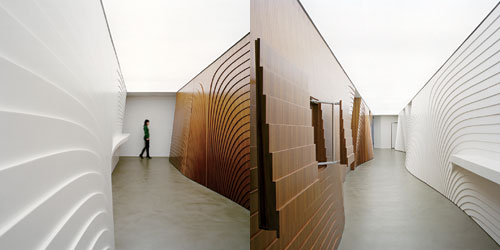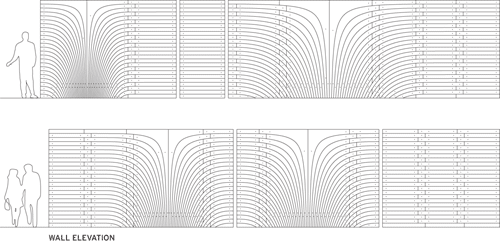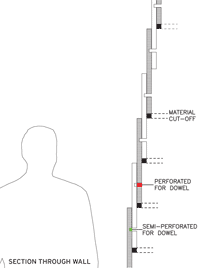When the Whole Is Greater Than the Sum of Its Parts
Across the globe in Vienna, Austria, another pioneering young architecture firm was using CNC milling to experiment with wall surfaces. Lilli Pschill and Ali Seghatoleslami, founding partners of PSA Architects, were hired to renovate expanded law offices inside a traditional, turn-of-the-20th-century Viennese building-traditional except for one unmissable element. Instantly recognized from the exterior, the building houses Coop Himmelb(l)au's radical rooftop addition of exploding glass and steel, an iconic architectural work completed 20 years earlier for the same client.
PSA's intervention is located on the building's second floor, one half of which contained a run-down apartment, and the other half, already refurbished offices. According to Pschill, "The main purpose of our project was to unite the two halves of the floor." Given its brave client, PSA turned a functional challenge into an aesthetic tour de force.
 |
|
The law offices' 9-foot-wide corridor is flanked by sculptural wall elements, parts of which curve out up to 2 feet. One side is composed of white Corian panels, the other walnut. A seamless ceiling and uniform floor keep attention focused on the walls (top). |
|
 |
|
|
Elevations illustrate the sinuous, two dimensional layout of the wall panels (above). The positioning of the panels relied on an array of predrilled dowels (left). Photo: © Hertha Hurnaus |
Â
They did so by articulating the long connecting corridor that spans those two areas. At 9 feet wide and nearly 60 feet long, the architects envisioned the corridor as more than just a circulation space. "We thought it could be used in a much more advantageous way, where people could have coffee or gather during a break in a meeting," Pschill says. "That's why we came up with these curving walls. They are like curtains that move you through the space and pull you into the conference rooms and offices that surround it."
Similar to a curtain, the walls are straight along the top edges to form a perfectly rectangular ceiling. A scrim conceals fluorescent light fixtures to create a luminous covering over the corridor. A cement based material-which extends beyond the field of the corridor to connect all adjacent spaces-gives the floor a continuous finish. These flat, seamless elements keep attention focused on the sculptural walls, which curve out up to 2 feet at the lower portions as they swerve along the floor. For functional reasons, a 3/4-inch gap separates the walls from both the ceiling and the floor.
Like Belzberg, PSA turned to a local shop with a CNC mill to fabricate the panels in a week's time. The panels of one wall are composed of 1/2-inch-thick white Corian, while slightly thinner, walnut laminated-plywood panels make up the darker, opposite wall.

|
Â
"The form came first, then we had to figure out how to make it," Pschill recalls. PSA designed the three-dimensional form in Rhino, but it was the appearance of the lines on the two-dimensional wall elevations that inspired the firm to slice the bulging surfaces into layers, or sediments, that run parallel to the wall itself and overlap each other. The architects call their finished walls "structural ornament." Within that ornament, they concealed infrastructure, electrical panels, and a thermostat, while incorporating a refrigerator, coffee bar, pull-out cabinets, a long shelf (made from CNC-milled, heat-molded Corian), and a flat-screen television, making a reality of PSA's vision of the corridor as a lively gathering space.
Installation of the panels and accompanying elements was not nearly as complicated as their intricate assembly might suggest. The almost 550 curving panels contain 2,550 predrilled holes for dowels-also executed by CNC machines-that attach one panel to the next. "Because of the predrilled dowel locations, the panels were self-positioning," Pschill explains. "When the installers came on-site, they just had to stick the pieces together. It would have been impossible without the CNC milling."









